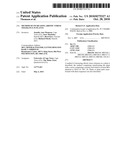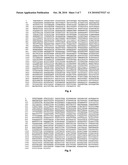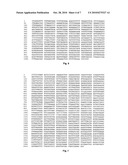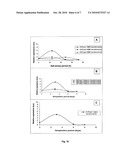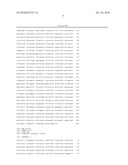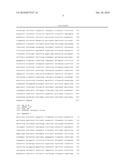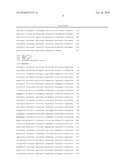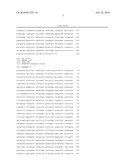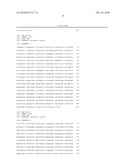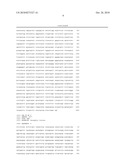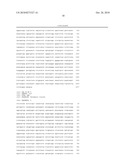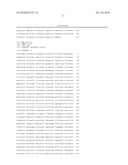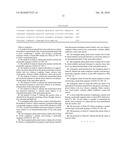Patent application title: METHOD OF INCREASING ABIOTIC STRESS TOLERANCE IN PLANTS
Inventors:
Jennifer Ann Thomson (Cape Town, ZA)
Jesse Machuka (Nairobi, KE)
Revel Iyer (Estcourt, ZA)
Richard Okoth (Nairobi, KE)
Assignees:
University of Cape Town
The Maize Trust
IPC8 Class: AA01H500FI
USPC Class:
800278
Class name: Multicellular living organisms and unmodified parts thereof and related processes method of introducing a polynucleotide molecule into or rearrangement of genetic material within a plant or plant part
Publication date: 2010-10-28
Patent application number: 20100275327
Claims:
1. A method of increasing abiotic stress tolerance in a plant, the method
comprising the step of transforming the plant with a vector comprising a
nucleic acid having a nucleotide sequence which is at least 80% identical
to SEQ I.D. NO: 10 to yield a transformed plant.
2. The method of claim 1, wherein the nucleic acid has the nucleotide sequence of SEQ I.D. NO: 10.
3. The method of claim 1, wherein the nucleic acid has the nucleotide sequence of SEQ I.D. NO: 1.
4. The method of claim 1, wherein the plant is an agricultural crop plant selected from the group consisting of maize, barley, oats, rye, tobacco, sorghum, wheat, cassava, rice, sweet potato, soybean, alfalfa, sunflower, cotton and canola.
5. The method of claim 1, wherein the transformed plant has increased tolerance to abiotic stress relative to an untransformed plant of the same plant species.
6. The method of claim 1, wherein the transformed plant has increased tolerance to cold stress relative to an untransformed plant of the same plant species.
7. The method of claim 1, wherein the transformed plant has increased tolerance to osmotic stress relative to an untransformed plant of the same plant species.
8. The method of claim 7, wherein the osmotic stress is selected from the group consisting of heat, drought, desiccation, freezing and high salt.
9. A transgenic plant, plant tissue or plant cell produced by the method of claim 1, which comprises a nucleic acid having a nucleotide sequence which is at least 80% identical to SEQ I.D. NO: 10 and which exhibits increased tolerance to abiotic stress relative to an untransformed plant of the same plant species.
10. The transgenic plant, plant tissue or plant cell of claim 9, which comprises a nucleic acid having a nucleotide sequence of SEQ I.D. NO: 10.
11. The transgenic plant, plant tissue or plant cell of claim 9, which is an agricultural crop plant or part thereof selected from the group consisting of maize, barley, oats, rye, tobacco, sorghum, wheat, cassava, rice, sweet potato, soybean, alfalfa, sunflower, cotton and canola.
12. The transgenic plant, plant tissue or plant cell of claim 9, which exhibits increased tolerance to cold stress relative to an untransformed plant of the same plant species.
13. The transgenic plant, plant tissue or plant cell of claim 9, which exhibits increased tolerance to osmotic stress relative to an untransformed plant of the same plant species.
14. Transgenic seeds produced by the transgenic plant of claim 9, wherein the seeds comprise a nucleic acid having a nucleotide sequence which is at least 80% identical to SEQ I.D. NO: 10.
15. Transgenic seeds of claim 14, which comprise a nucleic acid having a nucleotide sequence of SEQ I.D. NO: 10.
16. Transgenic seeds of claim 14, which are seeds of an agricultural crop plant selected from the group consisting of maize, barley, oats, rye, tobacco, sorghum, wheat, cassava, rice, sweet potato, soybean, alfalfa, sunflower, cotton and canola.
17. A stress-inducible promoter comprising a nucleic acid having a nucleotide sequence that is at least 80% identical to SEQ I.D. NO: 10 and which is capable of enhancing the abiotic stress tolerance of a plant that has been transformed with the nucleic acid.
18. The promoter of claim 17, which comprises a nucleic acid having a nucleotide sequence of SEQ I.D. NO: 10.
19. The promoter of claim 17, wherein the abiotic stress is cold stress.
20. The promoter of claim 17, wherein the abiotic stress is osmotic stress.
Description:
CROSS REFERENCE TO RELATED APPLICATIONS
[0001]The present application claims the benefit of PCT/IB2008/054628, filed Nov. 6, 2008 and South African Application No. 2007/09551, filed Nov. 6, 2007, the disclosures of which are expressly incorporated herein by reference in their entireties.
BACKGROUND OF THE INVENTION
[0002]The invention describes plant promoters which are useful, for example, in agricultural biotechnology. In particular, the promoters are inducible under abiotic stress conditions, and can be used to develop transgenic plants which can express genes to ameliorate some adverse effects of abiotic stress.
[0003]To express coding regions of given genes that are included in transformation vectors or in DNA constructs it is required that a promoter is engineered upstream of the coding sequence. Promoters can now be selected that either allow constitutive gene expression or limit gene expression to only specific cell types or in response to specific environmental stimuli. There is a need to generate drought tolerant transgenic plants that express transgenes only under stress conditions, since overproduction of such proteins when constitutively expressed may hamper the normal growth of plants. This would be especially valuable in economically valuable crops such as maize and tobacco.
[0004]Under constitutive gene expression there is gene expression all the time and at high levels. Examples of constitutive promoters include the Cauliflower Mosaic Virus promoter for 35S RNA and the maize ubiquitin promoter. It has been reported that constitutive expression of proteins under normal growth conditions sometimes hampers the normal growth of transgenic plants, resulting in smaller phenotypes as compared to wild-type plants. This unwanted dwarfing of the transformed plants may be due to the expression of the protein in higher amounts than normal and at stages when it is not needed.
[0005]Some genes encode products that are only required under special conditions related to developmental stages of the plant, environmental stress, or pathogen attack. These genes contain `inducible promoters` that can be turned on quickly by an inducer agent and are active for a limited length of time before they are turned off again. In the absence of an inducer, the DNA sequences or genes will not be transcribed. The inducer can be a chemical agent, or a physiological stress directly imposed upon the plant such as cold, heat, salt, toxins, or through the action of a pathogen or disease agent. A number of promoters that are inducible by anaerobic stress, high temperature stress, low temperature stress and salt stress have been described. However, it has been found that most of the stress-inducible promoters have poor strength of expression when compared to constitutive promoters.
[0006]Due to the poor strength of expression of inducible promoters when compared to constitutive promoters there is a need for the development of stress-responsive promoters that allow increased expression, but without any negative impact on their induction patterns.
[0007]The applicant has identified a need to provide transgenic plants which can express genes to ameliorate the adverse effects of abiotic stress, and to this end has isolated a promoter for inducing expression of proteins in plants during abiotic stress conditions. Abiotic stresses are deleterious effects on plants caused by non biological agents such as drought, salinity, cold and extreme temperatures while biotic constraints are usually attributed to living systems like bacteria, fungi, viruses that cause diseases and insects that feed on plants.
SUMMARY OF THE INVENTION
[0008]The invention provides an isolated nucleic acid comprising the nucleotide sequence which is at least 80% identical to: [0009](a) any one of SEQ I.D. NOs: 1-3 and 10; [0010](b) a fragment of any one of SEQ I.D. NOs: 1-3 and functions as a stress inducible promoter; [0011](c) a sequence which hybridizes under standard or stringent conditions to the nucleotide sequence of any one of SEQ I.D. NOs: 1-3 and functions as a stress inducible promoter; [0012](d) a complement of any one of SEQ I.D. NOs: 1-3 (SEQ I.D. NOs: 4-6); [0013](e) a sequence which hybridizes under standard or stringent conditions to the complement of any one of SEQ I.D. NOs: 1-3 and functions as a stress inducible promoter; [0014](f) a reverse complement of any one of SEQ I.D. NOs: 1-3 (SEQ I.D. NOs: 7-9); or [0015](g) a degenerate or allelic variant of any one of SEQ I.D. NOs: 1-3.
[0016]More preferably, the nucleotide sequence may have at least 90% identity to any one of (a)-(g) above.
[0017]More preferably, the nucleotide sequence may have at least 95% identity to any one of (a)-(g) above.
[0018]Even more preferably, the nucleotide sequence may comprise the nucleotide sequence of SEQ I.D. NO: 1 or 10 or a truncated sequence thereof, such as SEQ I.D. NO: 2 or SEQ I.D. NO: 3.
[0019]The nucleic acid may be a stress inducible plant promoter, and the stress may be an abiotic stress such as osmotic stress, dehydration stress, drought, salinity, cold, heat, dessication or extreme temperatures.
[0020]The nucleic acid may be derived from Xerophyta viscosa.
[0021]Hybridization may occur under stringent conditions that include a wash in 0.1 SSC at about 60 to about 65° C.
[0022]The invention extends to a plant vector including the promoter. The vector may also contain a gene downstream of the promoter.
[0023]The recombinant vector may be a T-derived plasmid construct of Agrobacterium tumefaciens.
[0024]The invention also extends to a host cell into which the vector has been transformed.
[0025]The host cell may be a plant cell.
[0026]The invention further extends to a transgenic plant or plant part transformed with the promoter. The transgenic plant or plant part may also be transformed with a gene under the control of the promoter. The gene may be any suitable gene, such as XvSap1, XvPrx2 or XvPer1.
[0027]The plant may be capable of expressing the gene in stress conditions.
[0028]The transgenic plant may be a monocotyledonous or dicotyledonous plant, such as maize, tobacco, sorghum, wheat, cassava, barley, oats, rye, sweet potatoes, soybean, alfalfa, tobacco, sunflower, cotton, or canola.
[0029]The transgenic plant parts may be selected from the group consisting of: cells, protoplasts, cell tissue cultures, callus, cell clumps, embryos, pollen, ovules, seeds, flowers, kernels, ears, cobs, leaves, husks, stalks, roots, root tips, anthers, seeds and silk.
[0030]The invention also provides a method for enhancing the stress tolerance of a plant by introducing a promoter comprising the nucleic acid of claim 1, and optionally also a gene under control of the promoter, into the plant.
BRIEF DESCRIPTION OF THE FIGURES
[0031]FIG. 1: Nucleotide sequence of promoter XvPsap1 (2083 bp, SEQ I.D. NO: 1).
[0032]FIG. 2: Nucleotide sequence of promoter XvPsap2 (1577 bp, SEQ I.D. NO: 2).
[0033]FIG. 3: Nucleotide sequence of promoter XvPsap3 (1127 bp, SEQ I.D. NO: 3).
[0034]FIG. 4: Complementary sequence of promoter XvPsap1 (2083 bp, SEQ I.D. NO: 4).
[0035]FIG. 5: Complementary sequence of promoter XvPsap2 (1577 bp, SEQ I.D. NO: 5).
[0036]FIG. 6: Complementary sequence of promoter XvPsap3 (1127 bp, SEQ I.D. NO: 6).
[0037]FIG. 7: Reverse complementary sequence of promoter XvPsap1 (2083 bp, SEQ I.D. NO: 7).
[0038]FIG. 8: Reverse complementary sequence of promoter XvPsap2 (1577 bp, SEQ I.D. NO: 8).
[0039]FIG. 9: Reverse complementary sequence of promoter XvPsap3 (1127 bp, SEQ I.D. NO: 9).
[0040]FIG. 10: Expression profile curves of luc transcripts using qRT-PCR analyses. A: Expression profile in transgenic BMS cells following treatment with 200 mM NaCl for 72 hours. B: Expression profile following dehydration treatment of transgenic tobacco plants for 8 days. C: Expression profile following dehydration treatment of transgenic maize. Only the XvPsap1 construct was used to transform maize. Analysis of variance was conducted at P<0.05.
[0041]FIG. 11: Nucleotide sequence of promoter XvPsap1 (SEQ I.D. NO: 10).
DETAILED DESCRIPTION OF THE INVENTION
[0042]Abiotic stress-inducible promoters for driving the expression of genes for the production of abiotic stress-resistant transgenic plants are described herein. Vectors containing the promoter and a gene operably associated with the promoter, and plants or plant parts transformed with the promoter and gene are also described.
[0043]Given the complexity of water use in land plants, especially during conditions that produce water deficit, the applicant is aware of only two promoters specifically associated with this aspect of plant physiology are commercially available. These promoters are derived from rice and Arabidopsis.
[0044]Promoters possess core and regulatory regions. The regulatory region is what differentiates promoters. These regulatory regions generally consist of negative regulatory elements, transcriptional enhancers, translational enhancers and other regulatory elements. Three lengths of the DNA promoter of the present invention have been synthesised (SEQ I.D. NOs: 1-3 and 10). These would differ in the regulatory regions. Consequently their activity and effectiveness might differ in different plants and under different stress conditions. Thus, each of the promoters may be recommended for use in different plants subjected to different stresses.
[0045]The DNA promoters of the present invention are derived from a `resurrection plant`, Xerophyta viscosa, which can withstand extreme desiccation, surviving for months with only 5% relative water content. Upon watering it can rehydrate within 80 hours.
[0046]The Xerophyta viscosa genome has not been sequenced. Consequently, the base sequence of the DNA promoter of the present invention would not be identifiable were it not isolated and cloned. Furthermore, the DNA promoters of the present invention are truncated forms of the naturally occurring promoter.
[0047]The DNA promoters of the present invention do not code for any known functional protein. Their biological function is linked to the expression of a protein, which increases the stress tolerance of Xerophyta viscosa. The promoters lack any significant identity to the two commercially available promoters or to any other known promoter sequence.
[0048]Although promoters having nucleotide sequences of SEQ I.D. NOs: 1-3 and 10 are described herein, it is envisaged that sequences which have 80% identity or more and which are functional promoters could also be used in the invention. Complementary sequences (SEQ I.D. NOs: 4-6), reverse complementary sequences (SEQ I.D. NOs: 7-9) and sequences which hybridise to these sequences, under standard or stringent conditions, could also be used, provided that they have promoter activity (FIGS. 4-9).
[0049]For example, hybridisation can be carried out for 18 h at 65° C. with gentle shaking, a first wash for 12 min at 65° C. in Wash Buffer A (0.5% SDS; 2×SSC), and a second wash for 10 min at 65° C. in Wash Buffer B (0.1% SDS; 0.5×SSC).
[0050]The DNA promoters can be induced by environmental stresses, such as drought, without the application of chemicals. They allow for expression of a desired protein or mRNA within a short period of applying the stimulus.
[0051]The promoter may be inserted into a plant vector. Genes that could generate transgenic plants tolerant to abiotic stresses, such as XvSap1, XvPrx2 or XvPer1, can be cloned downstream of the promoter. When such a composite construct is introduced into a transgenic plant, the gene will only be expressed when the plant is subjected to an abiotic stress. Thus, plants susceptible to abiotic stress like maize, tobacco, sorghum, wheat, cassava and sweet potatoes that are physiologically normal under non-stressed conditions can be produced.
Methodology
[0052]The invention is described in more detail by way of the following methodology, which is not to be construed as limiting in any way either the spirit or scope of the invention.
[0053]The splinkerette protocol was employed to obtain the upstream genomic sequence of XvSap1 (AY100455). This protocol was modified from Devon et al. (1995). Truncated versions of the promoter were generated by selective amplification of the full length promoter region.
[0054]The gene expression performances of a drought-inducible promoter isolated from Xerophyta viscosa, XvPsap1 (SEQ I.D. NO. 1; FIG. 1 and SEQ I.D. NO: 10; FIG. 11) and its truncated fragments XvPsap2 (SEQ I.D. NO. 2; FIG. 2) and XvPsap3 (SEQ I.D. NO. 3; FIG. 3) were determined by Agrobacterium-mediated transformation of Nicotiana tabacum and Black Mexican Sweetcorn (BMS) cells with expression casettes containing the truncated promoters individually driving the expression of the luc reporter gene followed by a nos terminator. In addition, an expression cassette, containing XvPsap1 driving the expression of the luc reporter gene followed by a nos terminator, was transformed into maize.
[0055]To determine whether these promoters are stress-inducible, transcriptional analyses of luc in response to salt and dehydration stress were performed on transgenic cells and plants using quantitative real-time PCR (qPCR). Transgenic BMS cells were subjected to 200 mM NaCl salt stress. Transgenic tobacco and maize were exposed to dehydration treatment.
[0056]The qPCR analysis of the BMS cells indicated that luc mRNA was upregulated within 24 hours of salt stress for both XvPsap1 (5 fold; P<0.05) and XvPsap2 (1.9 fold; P<0.05) whereas with XvPsap3 (1.9 fold; P<0.05) upregulation occurred after 48 hours (FIG. 10A). A similar trend was observed with dehydrated tobacco, in which optimal expression levels were recorded 72 hours after initiating dehydration. The XvPsap1 activity was significant (7 fold; P<0.05) in transgenic tobacco whereas XvPsap2 and XvPsap3 displayed 2.2 and 1.6 fold increases, respectively (FIG. 10B). In dehydrated maize, XvPsap1 also displayed a significant peak in activity on the third day with a relative luc expression of 4 fold (FIG. 10C). Together, these results suggest that the XvPsap1 promoter is the most active and would be involved in the early responses to drought as it peaks shortly after transgenic plants are subjected to lack of water.
[0057]These findings are validated by Garwe et al. (2003, 2006) who isolated XvSap1 gene which XvPsap1 promoter naturally regulates in X. viscosa. They found that XvSap1 gene confers tolerance to dehydration, high temperatures and salinity in model plants. More recently, Iyer at al. (2007) reported a similar trend with the expression of XvSap1 gene in dehydrated X. viscosa. They noted an up-regulation of the XvSap1 mRNA at 60% relative water content. Thereafter, expression decreased but again increased at 15% RWC. This observation led them to conclude that XvSap1 could be involved in the initial and late stages of the protective response to dehydration.
[0058]It is anticipated that the gene expression of this stress tolerant maize line could be induced by environmental stress such as drought, without the need for the application of chemicals such that the stress tolerant maize will maintain its cellular membrane integrity and survive the adverse effects of reactive oxygen species (ROS) experienced during drought stress.
[0059]The following list of references are expressly incorporated herein by reference in their entireties.
[0060]Devon R S Porteous D J & Brokkes A J (1995) `Splinkerettes--improved vectorettes or greater efficiency in PCR walking` Nucleic Acids Research 23:1644-1645.
[0061]Galun E & Breiman A (1996) `Transgenic plants` Imperical College Press, USA.
[0062]Garwe D Thomson J A & Mundree S G (2003) `Molecular characterization of XVSAP1, a stress-responsive gene from the resurrection plant Xerophyta viscosa Baker` Journal of Experimental Botany 54:191-201.
[0063]Garwe D Thomson J A & Mundree S G (2006) `XvSAP1 from Xerophyta viscosa improves osmotic-, salinity- and high-temperature-stress tolerance in Arabidopsis` Biotechnology Journal 1:1-10.
[0064]Iyer R Mundree S G Rafudeen M S & Thomson J A (2007) `XvSap1, a desiccation tolerance associated gene with potential for crop improvement` In Plant Desiccation Tolerance Jenks M A & Wood A J (eds.) Blackwell Publishing, UK 283-296.
[0065]Kasuga M Liu Q Miura S Yamaguchi-Shinozaki K & Shinozaki K (1999) `Improving plant drought, salt, and freezing tolerance by gene transfer of a single-inducible transcription factors` Nature Biotechnology 17: 287-291.
[0066]Liu Q Kasuga M Sakuma Y Abe H Miura S Yamaguchi-Shinozaki K & Shinozaki K (1998) `Two transcriptional factors, DREB1 and DREB2, with an EREBP/AP2 DNA binding domain separate two cellular signal transduction pathways in drought and low temperature-responsive gene expression, respectively, in Arabidopsis` Plant Cell 10:1391-1406.
[0067]Su J Shen Q Ho D T & Wu R (1998) Dehydration-stress-regulated transgene expression in stably transformed rice plants' Plant Physiology 117:913-922.
Sequence CWU
1
1012083DNAXerophyta viscosa 1actgtctggg tagctggcaa tatagagacg taagaaattc
atggatcatc accctaattc 60ggtctttcac tcattttatc ctagacctga ctaaaaaact
tggtcagagt tttacttatt 120taaaaaaaag aggacttcat ggcatccatg tgcaggtaca
gctcccagaa aaaaaaagca 180tgaaacacga caggatcaat agcattcgat ctgaaacaaa
aggttggagc tcaagacttt 240ctccaaaata ttaagatgat ccaaagaatt accccaagat
atccaacgta taccaatgtg 300tataccgaaa gtaagaaagt tcacgtgcat tctttgattt
ttctcccgag tgttcttttc 360tgaaatgagt aaataagact agaataagag ctaatgtatt
ttttttctaa aaaaaagttg 420aatgtggata caatatgatt atacattcat tagctatttt
aagtatattc tatttttttt 480ccccccaaaa gaacacaaat gtgttccgtc actttccatg
gggcaaatta caacttaggc 540tttatcttag ttggtatgat cttaatttta ttatacttta
aacaacttat cgctaataat 600tttgttttga tttatgcgcc aattgtaaat ataaatcgga
taaatttgaa cattaatact 660tttagtcagt ttcaaaaaag aaaaagataa ctatgacgtt
agagtttgga atccagtcaa 720atggaactta ttttttagtt catcagaatc aacttgatga
gattttttgt actagacaat 780catcttgaat gatagatagg ggacttacca atcagccccc
catattttga aactttcaac 840gcgcccctca acatttttct ctttcaacgc gcccttccat
cacttttctc ttttcatcgc 900ccctccctca actttttggt cggacggaaa tacctctata
tatatttcat catttcgacc 960cccaaaacac ctatttagaa gtattttttg gaaaaaattt
taacatgaaa gttttagatc 1020ttgatgagat ctacaatttt tatgttgaaa gtttttccaa
aaaatacttt tagatagata 1080ttttggaact ccgaagtgtt aatgggtcga cccgctaact
tgcggaaata gaaaaacatc 1140aagatctaca acttttatgt tgaaagtttt ttcaaaaaat
acttctagat agatatttga 1200tttgtaattt taatgttgaa agttttttca aaaaatactt
ctagatagat actttggggc 1260tccggagtgt taacaagtat aggaatattt ttgtctgcaa
aaaattaatt tttcggacaa 1320gaggccgatc agtaaggaat ctggtcggag gggctgttcg
gcaatataag ttcagatagg 1380agaactgatc ggatattttt ccttaattta attccaattt
gatactatta agaatgaaaa 1440catcctaata attgtgacca ctttatagca ccacatttat
tttaatttaa atcttttaaa 1500tcttagaatt ggacagggtg cttatgataa caaacttgtt
cctatcaaca actgcatgtt 1560agacagcgcc gaatttacag tcctactggg cgccactttt
caacccacat catcaagatg 1620aacaccacgt tatcttcatc cgctccaacc acatggtcca
gcgccactgg ccaagaccgc 1680cagccagcca ggccatccaa cgtggtgcat tttctaacac
tccacgttcg ctgtacggca 1740ttatttctcc agccagaaag accgagacag cgacgctgtt
gggcgggccc gcggcctgct 1800ctctctgctt ccccatgaga ttcacgggca tcgctcctcg
ctcgtgccta cgcccgcgcc 1860cgcgcccgac cgcgccggtc cacgtgacgt ggcgcagcaa
tcgttcttac taggcgcttg 1920cacgtgtcgt tcgcatgcga agcgtccaca ctgccaacga
cctccttaaa tatccttgtg 1980atattcgcct tacgatctca cacttcgcac gcaaaggcca
gtcgcagatt tgggttgaat 2040ttgctgcgtt ttggcagatt ttgagcgaga gatattaggg
aag 208321577DNAXerophyta viscosa 2cgtcactttc
catggggcaa attacaactt aggctttatc ttagttggta tgatcttaat 60tttattatac
tttaaacaac ttatcgctaa taattttgtt ttgatttatg cgccaattgt 120aaatataaat
cggataaatt tgaacattaa tacttttagt cagtttcaaa aaagaaaaag 180ataactatga
cgttagagtt tggaatccag tcaaatggaa cttatttttt agttcatcag 240aatcaacttg
atgagatttt ttgtactaga caatcatctt gaatgataga taggggactt 300accaatcagc
cccccatatt ttgaaacttt caacgcgccc ctcaacattt ttctctttca 360acgcgccctt
ccatcacttt tctcttttca tcgcccctcc ctcaactttt tggtcggacg 420gaaatacctc
tatatatatt tcatcatttc gacccccaaa acacctattt agaagtattt 480tttggaaaaa
attttaacat gaaagtttta gatcttgatg agatctacaa tttttatgtt 540gaaagttttt
ccaaaaaata cttttagata gatattttgg aactccgaag tgttaatggg 600tcgacccgct
aacttgcgga aatagaaaaa catcaagatc tacaactttt atgttgaaag 660ttttttcaaa
aaatacttct agatagatat ttgatttgta attttaatgt tgaaagtttt 720ttcaaaaaat
acttctagat agatactttg gggctccgga gtgttaacaa gtataggaat 780atttttgtct
gcaaaaaatt aatttttcgg acaagaggcc gatcagtaag gaatctggtc 840ggaggggctg
ttcggcaata taagttcaga taggagaact gatcggatat ttttccttaa 900tttaattcca
atttgatact attaagaatg aaaacatcct aataattgtg accactttat 960agcaccacat
ttattttaat ttaaatcttt taaatcttag aattggacag ggtgcttatg 1020ataacaaact
tgttcctatc aacaactgca tgttagacag cgccgaattt acagtcctac 1080tgggcgccac
ttttcaaccc acatcatcaa gatgaacacc acgttatctt catccgctcc 1140aaccacatgg
tccagcgcca ctggccaaga ccgccagcca gccaggccat ccaacgtggt 1200gcattttcta
acactccacg ttcgctgtac ggcattattt ctccagccag aaagaccgag 1260acagcgacgc
tgttgggcgg gcccgcggcc tgctctctct gcttccccat gagattcacg 1320ggcatcgctc
ctcgctcgtg cctacgcccg cgcccgcgcc cgaccgcgcc ggtccacgtg 1380acgtggcgca
gcaatcgttc ttactaggcg cttgcacgtg tcgttcgcat gcgaagcgtc 1440cacactgcca
acgacctcct taaatatcct tgtgatattc gccttacgat ctcacacttc 1500gcacgcaaag
gccagtcgca gatttgggtt gaatttgctg cgttttggca gattttgagc 1560gagagatatt
agggaag
157731127DNAXerophyta viscosa 3gacccccaaa acacctattt agaagtattt
tttggaaaaa attttaacat gaaagtttta 60gatcttgatg agatctacaa tttttatgtt
gaaagttttt ccaaaaaata cttttagata 120gatattttgg aactccgaag tgttaatggg
tcgacccgct aacttgcgga aatagaaaaa 180catcaagatc tacaactttt atgttgaaag
ttttttcaaa aaatacttct agatagatat 240ttgatttgta attttaatgt tgaaagtttt
ttcaaaaaat acttctagat agatactttg 300gggctccgga gtgttaacaa gtataggaat
atttttgtct gcaaaaaatt aatttttcgg 360acaagaggcc gatcagtaag gaatctggtc
ggaggggctg ttcggcaata taagttcaga 420taggagaact gatcggatat ttttccttaa
tttaattcca atttgatact attaagaatg 480aaaacatcct aataattgtg accactttat
agcaccacat ttattttaat ttaaatcttt 540taaatcttag aattggacag ggtgcttatg
ataacaaact tgttcctatc aacaactgca 600tgttagacag cgccgaattt acagtcctac
tgggcgccac ttttcaaccc acatcatcaa 660gatgaacacc acgttatctt catccgctcc
aaccacatgg tccagcgcca ctggccaaga 720ccgccagcca gccaggccat ccaacgtggt
gcattttcta acactccacg ttcgctgtac 780ggcattattt ctccagccag aaagaccgag
acagcgacgc tgttgggcgg gcccgcggcc 840tgctctctct gcttccccat gagattcacg
ggcatcgctc ctcgctcgtg cctacgcccg 900cgcccgcgcc cgaccgcgcc ggtccacgtg
acgtggcgca gcaatcgttc ttactaggcg 960cttgcacgtg tcgttcgcat gcgaagcgtc
cacactgcca acgacctcct taaatatcct 1020tgtgatattc gccttacgat ctcacacttc
gcacgcaaag gccagtcgca gatttgggtt 1080gaatttgctg cgttttggca gattttgagc
gagagatatt agggaag 112742083DNAXerophyta viscosa
4tgacagaccc atcgaccgtt atatctctgc attctttaag tacctagtag tgggattaag
60ccagaaagtg agtaaaatag gatctggact gattttttga accagtctca aaatgaataa
120attttttttc tcctgaagta ccgtaggtac acgtccatgt cgagggtctt tttttttcgt
180actttgtgct gtcctagtta tcgtaagcta gactttgttt tccaacctcg agttctgaaa
240gaggttttat aattctacta ggtttcttaa tggggttcta taggttgcat atggttacac
300atatggcttt cattctttca agtgcacgta agaaactaaa aagagggctc acaagaaaag
360actttactca tttattctga tcttattctc gattacataa aaaaaagatt ttttttcaac
420ttacacctat gttatactaa tatgtaagta atcgataaaa ttcatataag ataaaaaaaa
480ggggggtttt cttgtgttta cacaaggcag tgaaaggtac cccgtttaat gttgaatccg
540aaatagaatc aaccatacta gaattaaaat aatatgaaat ttgttgaata gcgattatta
600aaacaaaact aaatacgcgg ttaacattta tatttagcct atttaaactt gtaattatga
660aaatcagtca aagttttttc tttttctatt gatactgcaa tctcaaacct taggtcagtt
720taccttgaat aaaaaatcaa gtagtcttag ttgaactact ctaaaaaaca tgatctgtta
780gtagaactta ctatctatcc cctgaatggt tagtcggggg gtataaaact ttgaaagttg
840cgcggggagt tgtaaaaaga gaaagttgcg cgggaaggta gtgaaaagag aaaagtagcg
900gggagggagt tgaaaaacca gcctgccttt atggagatat atataaagta gtaaagctgg
960gggttttgtg gataaatctt cataaaaaac cttttttaaa attgtacttt caaaatctag
1020aactactcta gatgttaaaa atacaacttt caaaaaggtt ttttatgaaa atctatctat
1080aaaaccttga ggcttcacaa ttacccagct gggcgattga acgcctttat ctttttgtag
1140ttctagatgt tgaaaataca actttcaaaa aagtttttta tgaagatcta tctataaact
1200aaacattaaa attacaactt tcaaaaaagt tttttatgaa gatctatcta tgaaaccccg
1260aggcctcaca attgttcata tccttataaa aacagacgtt ttttaattaa aaagcctgtt
1320ctccggctag tcattcctta gaccagcctc cccgacaagc cgttatattc aagtctatcc
1380tcttgactag cctataaaaa ggaattaaat taaggttaaa ctatgataat tcttactttt
1440gtaggattat taacactggt gaaatatcgt ggtgtaaata aaattaaatt tagaaaattt
1500agaatcttaa cctgtcccac gaatactatt gtttgaacaa ggatagttgt tgacgtacaa
1560tctgtcgcgg cttaaatgtc aggatgaccc gcggtgaaaa gttgggtgta gtagttctac
1620ttgtggtgca atagaagtag gcgaggttgg tgtaccaggt cgcggtgacc ggttctggcg
1680gtcggtcggt ccggtaggtt gcaccacgta aaagattgtg aggtgcaagc gacatgccgt
1740aataaagagg tcggtctttc tggctctgtc gctgcgacaa cccgcccggg cgccggacga
1800gagagacgaa ggggtactct aagtgcccgt agcgaggagc gagcacggat gcgggcgcgg
1860gcgcgggctg gcgcggccag gtgcactgca ccgcgtcgtt agcaagaatg atccgcgaac
1920gtgcacagca agcgtacgct tcgcaggtgt gacggttgct ggaggaattt ataggaacac
1980tataagcgga atgctagagt gtgaagcgtg cgtttccggt cagcgtctaa acccaactta
2040aacgacgcaa aaccgtctaa aactcgctct ctataatccc ttc
208351577DNAXerophyta viscosa 5gcagtgaaag gtaccccgtt taatgttgaa
tccgaaatag aatcaaccat actagaatta 60aaataatatg aaatttgttg aatagcgatt
attaaaacaa aactaaatac gcggttaaca 120tttatattta gcctatttaa acttgtaatt
atgaaaatca gtcaaagttt tttctttttc 180tattgatact gcaatctcaa accttaggtc
agtttacctt gaataaaaaa tcaagtagtc 240ttagttgaac tactctaaaa aacatgatct
gttagtagaa cttactatct atcccctgaa 300tggttagtcg gggggtataa aactttgaaa
gttgcgcggg gagttgtaaa aagagaaagt 360tgcgcgggaa ggtagtgaaa agagaaaagt
agcggggagg gagttgaaaa accagcctgc 420ctttatggag atatatataa agtagtaaag
ctgggggttt tgtggataaa tcttcataaa 480aaaccttttt taaaattgta ctttcaaaat
ctagaactac tctagatgtt aaaaatacaa 540ctttcaaaaa ggttttttat gaaaatctat
ctataaaacc ttgaggcttc acaattaccc 600agctgggcga ttgaacgcct ttatcttttt
gtagttctag atgttgaaaa tacaactttc 660aaaaaagttt tttatgaaga tctatctata
aactaaacat taaaattaca actttcaaaa 720aagtttttta tgaagatcta tctatgaaac
cccgaggcct cacaattgtt catatcctta 780taaaaacaga cgttttttaa ttaaaaagcc
tgttctccgg ctagtcattc cttagaccag 840cctccccgac aagccgttat attcaagtct
atcctcttga ctagcctata aaaaggaatt 900aaattaaggt taaactatga taattcttac
ttttgtagga ttattaacac tggtgaaata 960tcgtggtgta aataaaatta aatttagaaa
atttagaatc ttaacctgtc ccacgaatac 1020tattgtttga acaaggatag ttgttgacgt
acaatctgtc gcggcttaaa tgtcaggatg 1080acccgcggtg aaaagttggg tgtagtagtt
ctacttgtgg tgcaatagaa gtaggcgagg 1140ttggtgtacc aggtcgcggt gaccggttct
ggcggtcggt cggtccggta ggttgcacca 1200cgtaaaagat tgtgaggtgc aagcgacatg
ccgtaataaa gaggtcggtc tttctggctc 1260tgtcgctgcg acaacccgcc cgggcgccgg
acgagagaga cgaaggggta ctctaagtgc 1320ccgtagcgag gagcgagcac ggatgcgggc
gcgggcgcgg gctggcgcgg ccaggtgcac 1380tgcaccgcgt cgttagcaag aatgatccgc
gaacgtgcac agcaagcgta cgcttcgcag 1440gtgtgacggt tgctggagga atttatagga
acactataag cggaatgcta gagtgtgaag 1500cgtgcgtttc cggtcagcgt ctaaacccaa
cttaaacgac gcaaaaccgt ctaaaactcg 1560ctctctataa tcccttc
157761127DNAXerophyta viscosa
6ctgggggttt tgtggataaa tcttcataaa aaaccttttt taaaattgta ctttcaaaat
60ctagaactac tctagatgtt aaaaatacaa ctttcaaaaa ggttttttat gaaaatctat
120ctataaaacc ttgaggcttc acaattaccc agctgggcga ttgaacgcct ttatcttttt
180gtagttctag atgttgaaaa tacaactttc aaaaaagttt tttatgaaga tctatctata
240aactaaacat taaaattaca actttcaaaa aagtttttta tgaagatcta tctatgaaac
300cccgaggcct cacaattgtt catatcctta taaaaacaga cgttttttaa ttaaaaagcc
360tgttctccgg ctagtcattc cttagaccag cctccccgac aagccgttat attcaagtct
420atcctcttga ctagcctata aaaaggaatt aaattaaggt taaactatga taattcttac
480ttttgtagga ttattaacac tggtgaaata tcgtggtgta aataaaatta aatttagaaa
540atttagaatc ttaacctgtc ccacgaatac tattgtttga acaaggatag ttgttgacgt
600acaatctgtc gcggcttaaa tgtcaggatg acccgcggtg aaaagttggg tgtagtagtt
660ctacttgtgg tgcaatagaa gtaggcgagg ttggtgtacc aggtcgcggt gaccggttct
720ggcggtcggt cggtccggta ggttgcacca cgtaaaagat tgtgaggtgc aagcgacatg
780ccgtaataaa gaggtcggtc tttctggctc tgtcgctgcg acaacccgcc cgggcgccgg
840acgagagaga cgaaggggta ctctaagtgc ccgtagcgag gagcgagcac ggatgcgggc
900gcgggcgcgg gctggcgcgg ccaggtgcac tgcaccgcgt cgttagcaag aatgatccgc
960gaacgtgcac agcaagcgta cgcttcgcag gtgtgacggt tgctggagga atttatagga
1020acactataag cggaatgcta gagtgtgaag cgtgcgtttc cggtcagcgt ctaaacccaa
1080cttaaacgac gcaaaaccgt ctaaaactcg ctctctataa tcccttc
112772083DNAXerophyta viscosa 7cttccctaat atctctcgct caaaatctgc
caaaacgcag caaattcaac ccaaatctgc 60gactggcctt tgcgtgcgaa gtgtgagatc
gtaaggcgaa tatcacaagg atatttaagg 120aggtcgttgg cagtgtggac gcttcgcatg
cgaacgacac gtgcaagcgc ctagtaagaa 180cgattgctgc gccacgtcac gtggaccggc
gcggtcgggc gcgggcgcgg gcgtaggcac 240gagcgaggag cgatgcccgt gaatctcatg
gggaagcaga gagagcaggc cgcgggcccg 300cccaacagcg tcgctgtctc ggtctttctg
gctggagaaa taatgccgta cagcgaacgt 360ggagtgttag aaaatgcacc acgttggatg
gcctggctgg ctggcggtct tggccagtgg 420cgctggacca tgtggttgga gcggatgaag
ataacgtggt gttcatcttg atgatgtggg 480ttgaaaagtg gcgcccagta ggactgtaaa
ttcggcgctg tctaacatgc agttgttgat 540aggaacaagt ttgttatcat aagcaccctg
tccaattcta agatttaaaa gatttaaatt 600aaaataaatg tggtgctata aagtggtcac
aattattagg atgttttcat tcttaatagt 660atcaaattgg aattaaatta aggaaaaata
tccgatcagt tctcctatct gaacttatat 720tgccgaacag cccctccgac cagattcctt
actgatcggc ctcttgtccg aaaaattaat 780tttttgcaga caaaaatatt cctatacttg
ttaacactcc ggagccccaa agtatctatc 840tagaagtatt ttttgaaaaa actttcaaca
ttaaaattac aaatcaaata tctatctaga 900agtatttttt gaaaaaactt tcaacataaa
agttgtagat cttgatgttt ttctatttcc 960gcaagttagc gggtcgaccc attaacactt
cggagttcca aaatatctat ctaaaagtat 1020tttttggaaa aactttcaac ataaaaattg
tagatctcat caagatctaa aactttcatg 1080ttaaaatttt ttccaaaaaa tacttctaaa
taggtgtttt gggggtcgaa atgatgaaat 1140atatatagag gtatttccgt ccgaccaaaa
agttgaggga ggggcgatga aaagagaaaa 1200gtgatggaag ggcgcgttga aagagaaaaa
tgttgagggg cgcgttgaaa gtttcaaaat 1260atggggggct gattggtaag tcccctatct
atcattcaag atgattgtct agtacaaaaa 1320atctcatcaa gttgattctg atgaactaaa
aaataagttc catttgactg gattccaaac 1380tctaacgtca tagttatctt tttctttttt
gaaactgact aaaagtatta atgttcaaat 1440ttatccgatt tatatttaca attggcgcat
aaatcaaaac aaaattatta gcgataagtt 1500gtttaaagta taataaaatt aagatcatac
caactaagat aaagcctaag ttgtaatttg 1560ccccatggaa agtgacggaa cacatttgtg
ttcttttggg gggaaaaaaa atagaatata 1620cttaaaatag ctaatgaatg tataatcata
ttgtatccac attcaacttt tttttagaaa 1680aaaaatacat tagctcttat tctagtctta
tttactcatt tcagaaaaga acactcggga 1740gaaaaatcaa agaatgcacg tgaactttct
tactttcggt atacacattg gtatacgttg 1800gatatcttgg ggtaattctt tggatcatct
taatattttg gagaaagtct tgagctccaa 1860ccttttgttt cagatcgaat gctattgatc
ctgtcgtgtt tcatgctttt tttttctggg 1920agctgtacct gcacatggat gccatgaagt
cctctttttt ttaaataagt aaaactctga 1980ccaagttttt tagtcaggtc taggataaaa
tgagtgaaag accgaattag ggtgatgatc 2040catgaatttc ttacgtctct atattgccag
ctacccagac agt 208381577DNAXerophyta viscosa
8cttccctaat atctctcgct caaaatctgc caaaacgcag caaattcaac ccaaatctgc
60gactggcctt tgcgtgcgaa gtgtgagatc gtaaggcgaa tatcacaagg atatttaagg
120aggtcgttgg cagtgtggac gcttcgcatg cgaacgacac gtgcaagcgc ctagtaagaa
180cgattgctgc gccacgtcac gtggaccggc gcggtcgggc gcgggcgcgg gcgtaggcac
240gagcgaggag cgatgcccgt gaatctcatg gggaagcaga gagagcaggc cgcgggcccg
300cccaacagcg tcgctgtctc ggtctttctg gctggagaaa taatgccgta cagcgaacgt
360ggagtgttag aaaatgcacc acgttggatg gcctggctgg ctggcggtct tggccagtgg
420cgctggacca tgtggttgga gcggatgaag ataacgtggt gttcatcttg atgatgtggg
480ttgaaaagtg gcgcccagta ggactgtaaa ttcggcgctg tctaacatgc agttgttgat
540aggaacaagt ttgttatcat aagcaccctg tccaattcta agatttaaaa gatttaaatt
600aaaataaatg tggtgctata aagtggtcac aattattagg atgttttcat tcttaatagt
660atcaaattgg aattaaatta aggaaaaata tccgatcagt tctcctatct gaacttatat
720tgccgaacag cccctccgac cagattcctt actgatcggc ctcttgtccg aaaaattaat
780tttttgcaga caaaaatatt cctatacttg ttaacactcc ggagccccaa agtatctatc
840tagaagtatt ttttgaaaaa actttcaaca ttaaaattac aaatcaaata tctatctaga
900agtatttttt gaaaaaactt tcaacataaa agttgtagat cttgatgttt ttctatttcc
960gcaagttagc gggtcgaccc attaacactt cggagttcca aaatatctat ctaaaagtat
1020tttttggaaa aactttcaac ataaaaattg tagatctcat caagatctaa aactttcatg
1080ttaaaatttt ttccaaaaaa tacttctaaa taggtgtttt gggggtcgaa atgatgaaat
1140atatatagag gtatttccgt ccgaccaaaa agttgaggga ggggcgatga aaagagaaaa
1200gtgatggaag ggcgcgttga aagagaaaaa tgttgagggg cgcgttgaaa gtttcaaaat
1260atggggggct gattggtaag tcccctatct atcattcaag atgattgtct agtacaaaaa
1320atctcatcaa gttgattctg atgaactaaa aaataagttc catttgactg gattccaaac
1380tctaacgtca tagttatctt tttctttttt gaaactgact aaaagtatta atgttcaaat
1440ttatccgatt tatatttaca attggcgcat aaatcaaaac aaaattatta gcgataagtt
1500gtttaaagta taataaaatt aagatcatac caactaagat aaagcctaag ttgtaatttg
1560ccccatggaa agtgacg
157791127DNAXerophyta viscosa 9cttccctaat atctctcgct caaaatctgc
caaaacgcag caaattcaac ccaaatctgc 60gactggcctt tgcgtgcgaa gtgtgagatc
gtaaggcgaa tatcacaagg atatttaagg 120aggtcgttgg cagtgtggac gcttcgcatg
cgaacgacac gtgcaagcgc ctagtaagaa 180cgattgctgc gccacgtcac gtggaccggc
gcggtcgggc gcgggcgcgg gcgtaggcac 240gagcgaggag cgatgcccgt gaatctcatg
gggaagcaga gagagcaggc cgcgggcccg 300cccaacagcg tcgctgtctc ggtctttctg
gctggagaaa taatgccgta cagcgaacgt 360ggagtgttag aaaatgcacc acgttggatg
gcctggctgg ctggcggtct tggccagtgg 420cgctggacca tgtggttgga gcggatgaag
ataacgtggt gttcatcttg atgatgtggg 480ttgaaaagtg gcgcccagta ggactgtaaa
ttcggcgctg tctaacatgc agttgttgat 540aggaacaagt ttgttatcat aagcaccctg
tccaattcta agatttaaaa gatttaaatt 600aaaataaatg tggtgctata aagtggtcac
aattattagg atgttttcat tcttaatagt 660atcaaattgg aattaaatta aggaaaaata
tccgatcagt tctcctatct gaacttatat 720tgccgaacag cccctccgac cagattcctt
actgatcggc ctcttgtccg aaaaattaat 780tttttgcaga caaaaatatt cctatacttg
ttaacactcc ggagccccaa agtatctatc 840tagaagtatt ttttgaaaaa actttcaaca
ttaaaattac aaatcaaata tctatctaga 900agtatttttt gaaaaaactt tcaacataaa
agttgtagat cttgatgttt ttctatttcc 960gcaagttagc gggtcgaccc attaacactt
cggagttcca aaatatctat ctaaaagtat 1020tttttggaaa aactttcaac ataaaaattg
tagatctcat caagatctaa aactttcatg 1080ttaaaatttt ttccaaaaaa tacttctaaa
taggtgtttt gggggtc 1127102083DNAXerophyta viscosa
10actgtctggg tagctggcaa tatagagacg taaataattg tctgtaaata gggagaaatt
60catggatcat caccctaatt cggtctttca ctcattttat catagacctg actaaagaac
120ttggtcagag tttttactta tttaaaataa agaggacttc atggcatcca tgtgcaggta
180cagctcccag aaaaaaaagc atgaaacacg agaggatcaa tagcattcga tctgaaacaa
240aaggttgcag ctcaagactt tctccaaaat attaagatga tccaaagaat taccccaaga
300tatccaacgt ataccaatgt gtataccgaa agtaagaaag ttcacgtgca ttctttgatt
360tttctcccga gtgttctttt ctgaaatgag taaataagac tagaataaga gctaatgtat
420tttttttcta aaaaaagttg aatgtggata caatatgatt atacattcat tagctatttt
480aagtatattc tatttttttt ccccccaaaa gaacacaaat gtgttccgtc actttccatg
540gggcaaatta caacttaggc tttatcttag ttggtatgat cttaatttta ttatacttta
600aacaacttat cgctaataat tttgttttga tttatgcgcc aattgtaaat aaatcggata
660aatttgaaca ttaatacttt tagtcaaagt ttcaaaaaag aaaaagataa ctatgacgtt
720agagtttgga atccagtcaa atggaactta ttttttagtt catcagaatc aacttgatga
780gattttttgt actagacaat catcttgaat gatagatagg ggacttacca atcagccccc
840catattttga aactttcaac gcgcccccca atatttttct ctttcaacgc gcccttccat
900cacttttctc ttttcatcgc ccctccctca actttttggt cggacggaaa tacctctata
960tatatttcat catttcgaca ccccaaaaca cttatttaga agtatttttt gaaaaaaatt
1020ttaacatgaa agttttagac cttgatgaga tctacaactt ttatgttgaa agtttttcca
1080aaaaatactt ttagatagat attttgaaac tccgaagtgt taatgggtcg acccgctaac
1140ttgcagaaat agaaaaacat caagatctac aatttttatg ttgaaagttt tttaaaaaaa
1200tatagataga tatttgattt ataattttaa tattgaaagt tttttcaaaa aatacttcta
1260gatagatatt ttgggactct ggaatgttac aagtatagga atatttttgt ctgtaaaaaa
1320ttaatttttc agacaaaggg ctgatcagta aggaatctgg tcgggggagc tgttcggcaa
1380tataagttca gataggagaa ctaatcggat atttttcctt aatttaattc cgatttgata
1440ctattaagaa tgaaaacatc ctaataattg tgaccacttt atagcaccac atttatttta
1500attttaatct tttaaatctt agaattggac agggtgctta tgatacaact tgttcctatc
1560aacaactgca tgttagacag cgccgaattt acagtcctac tgggcgccac ttttcaaccc
1620acatcatcaa gatgaacacc acgttatctt catccgctcc aaccacatgg tccagcgcca
1680ctggccaaga ccgccagcca gccaggccat ccaacgtggt gcattttcta acactccacg
1740ttcgctgtac ggcattattt ctccagccag aaagaccgag acagcgacgc tgttgggcgg
1800gcccgcggcc tgctctctct gcttccccat gagattcacg ggcatcgctc ctcgctcgtg
1860cctacgcgac cgcgccgatc cacgtgacgt ggcgcagcaa tcgttcttac taggcgcttg
1920cacgtgtcgt tcgcatgcga agcgtccaca ctgccaacga cctccttaaa tatccttgtg
1980atattcgcct tacgatctca cacttcgcac gcaaaggcca gtcgcagatt tgggttgaat
2040ttgctgcgtt ttggcagatt ttgagcgaga gatattaggg aag
2083
User Contributions:
Comment about this patent or add new information about this topic:

